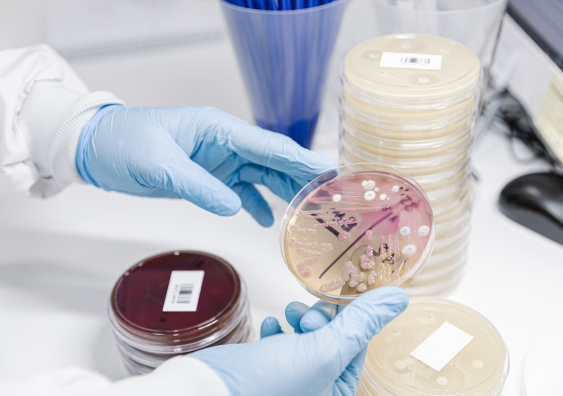Hidden threat: the rise of deadly fungal pathogens
Invasive fungal infections are a growing risk to human health worldwide.
Invasive fungal infections are a growing risk to human health worldwide.

Ben Knight
UNSW Media & Content
(02) 9065 4915
b.knight@unsw.edu.au
Thinking of fungi probably conjures up an image of some or a in your mind. That, or maybe a time where you had an unfortunate itchy skin rash that went away with a bit of topical medication.Ā
But researchers in mycology ā the study of fungi ā have long warned that fungi can have a much more sinister side. While weāre unlikely to see a pandemic play out ā certainly not along the lines of scenarios portrayed in fictional TV series The Last of Us ā real-life scientists are worried about rising rates and severity of fungal infections worldwide.
āFungi have historically been overlooked in infectious disease research,ā says Dr Megan Lenardon, a microbiologist and a senior lecturer in UNSWās School of Biotechnology and Biomolecular Sciences. āThere are many pathogens with different transmission routes and many challenges with therapies and diagnostics.āĀ
The threat of fungal pathogens is now gaining worldwide attention from public health bodies. The recently released its first-ever ā species of highest concern that require serious attention.
Dr Lenardon has been studying the cell and molecular biology ofĀ Candida albicans,Ā which was identified as one of the four fungi of critical priority.Ā CandidaĀ species cause non-serious infections like thrush in tens of millions of people per year. But of more concern are the 700,000 invasive infections that can kill people, about half of which are caused by C. albicans.
āWe call them āopportunistic invasiveā fungal pathogens because they donāt kill healthy people,ā Dr Lenardon says. āBut if they find themselves in a host who is susceptible, then they can kill.ā
Some fungi, like Aspergillus and Cryptococcus,Ā are breathed in through spores that exist everywhere in the environment but are usually no match for our immune systems. Others, likeĀ C. albicans,Ā colonise the gut of healthy individuals, but the physical barrier between the bloodstream, gut microbiota and a firing immune system is generally enough to prevent infections.
Read more:Ā
But when these defences are compromised, it can leave us vulnerable to infection. In immunocompromised people,Ā C. albicansĀ can escape the gut, circulate throughout the blood, and invade organs.
āSerious fungal infections are more of a risk for people with underlying health conditions,ā Dr Lenardon says. āPeople with cancer or HIV/AIDS, organ transplant recipients, and intensive care patients are among those who are more vulnerable to infection.ā
While the likelihood of acquiring a severe fungal infection is rare, infection is often deadly. At least despite the availability of antifungals. By comparison, a nasty bacterial infection like .
According to new estimates, there are globally each year associated with severe fungal disease.
āThe number of deaths from fungal infections is also likely underreported,ā Dr Lenardon says. āUsually, an existing health condition is recorded as the cause of death when the fungal infection was responsible.ā

40 per cent of systemic C. albicans infections are fatal despite the availability of antifungal medication. Photo: Getty Images.
Like antibiotic resistance, there is also increasing worry over antifungal resistance. Overusing and misusing antifungal medications in agriculture and healthcare settings can develop resistant strains, making infections harder to treat.
āW³ó±š²ŌĢżCandida auris first emerged in healthcare settings in the late 2000s, it was already drug-resistant,ā Dr Lenardon says. āWeāre seeing more and more resistance in the clinic to existing antifungal treatments, so antifungal stewardship is crucial.āĀ
Serious fungal infections can also be difficult for medical practitioners to diagnose. Symptoms can vary drastically between fungus types and often present just like bacterial infections.Ā
āSo, time to diagnosis is a problem, and there arenāt a lot of specialist clinical mycologists,ā Dr Lenardon says.
Read more:Ā
Another problem is the few drugs available to treat serious fungal infections. There are only for use in clinical settings ā thatās compared to at least . Some of these antifungal treatments also inadvertently target human cells, while others arenāt very effective.
āFungi are biologically very similar to us, so there are very few differences between fungal cells and human cells that we can exploit in therapy,ā Dr Lenardon says. āThe things that we do exploit are sometimes quite toxic to us because they target not only fungal cell membranes but human cell membranes too.ā
Developing new fungal treatments remains a challenge. Among infectious disease research, mycology is also a relatively small field and receives just a fraction of funding compared to bacteria, viruses and parasites. Few preventative treatments are in the drug pipeline, and no vaccines are imminent.
Despite this, Dr Lenardon says weāre unlikely to see a fungi outbreak sweep through humans at this stage. One reason is because most serious (life threatening) fungal pathogens that affect people are generally not transmissible from human to human.
However, some contagious fungal infections occur in other animal species, such as white-nose syndrome caused by the fungus Pseudogymnoascus destructans, which decimates bat populations. Still, no deadly fungal pathogens have been known to jump the species barrier from animals to humans.
āEven though no fungi right now are likely to cause a pandemic like COVID-19, we shouldnāt be complacent,ā Dr Lenardon says. āEmerging fungal diseases still pose a significant risk, especially as the number of people at risk of infection is expected to grow.ā
Read more:Ā
In other good news, most fungal species also canāt survive at the temperature of the human body. However, there are some fears that as the world continues to heat up from climate change, some may be able to adapt to overcome the temperature barrier.
āFungi may evolve to resist higher temperatures, which means we might see the emergence of a species that can survive in our bodies,ā Dr Lenardon says. āThe overall risk of a pandemic, though, is probably still relatively low, and these pathogens would still have to get past our immune systems.ā
But Dr Lenardon says weāre underprepared to deal with a fungal pandemic should one break out tomorrow. More coordinated research is needed to stay on top of emerging threats, which requires more investment.
āStrengthening surveillance networks is critical to identifying any potential fungal threats before they arise,ā Dr Lenardon says. āWe also desperately need more funding to address the urgent clinical need for better diagnostics and new therapies.ā